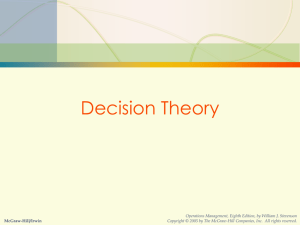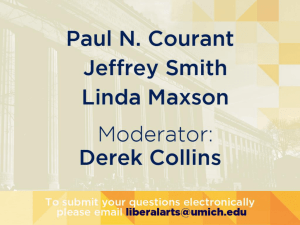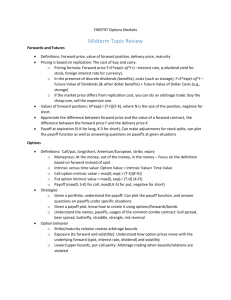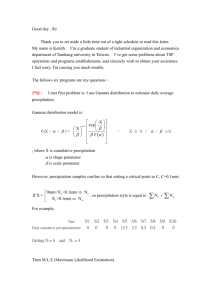Decision Making Under Uncertainty
advertisement
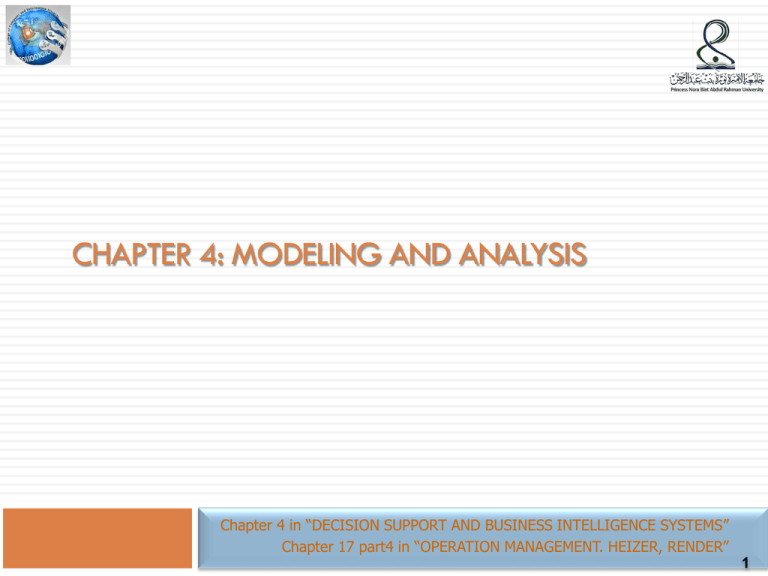
CHAPTER 4: MODELING AND ANALYSIS Chapter 4 in “DECISION SUPPORT AND BUSINESS INTELLIGENCE SYSTEMS” Chapter 17 part4 in “OPERATION MANAGEMENT. HEIZER, RENDER” 1 MSS Modeling 2 Modeling is a key element in most DSS/business intelligence (also business analytics) and a necessity in a model-based DSS. There are many classes of models, and there are often many specialized techniques for solving each one MSS Modeling 3 DSS Models Algorithm-based models Example: To make cost estimation. This model is programmed directly in the DSS. Statistic-based models Example :demand forecasting Linear programming models Example : A transportation model to determine the best shipping from product sources to distribution centers (fed to it from the previous model) and hence to customers. Graphical models Example :A geographic information system Qualitative models Example :A financial and risk simulation model Simulation models Quantitative models (mathematical Models) MSS Modeling (Cont.) 4 There are some major modeling issues include: Problem identification and environment analysis Variable identification Forecasting The use of multiple model Model categories Model management KNOWLEDGE-BASED modeling Problem Identification 5 Environmental scanning and analysis, which is the monitoring, scanning and interpretation of collected information. It is important to analyze the scope of the domain and forces and dynamics of the environment. A decision maker need to identify the organizational culture and the corporate decision-making processes. The problem must be understood, and everyone involve should share the same frame. MSS Modeling (Cont.) 6 There are some major modeling issues include: Problem identification and environment analysis Variable identification Forecasting The use of multiple model Model categories Model management KB modeling Variable identification 7 Identification of the model variables, which are decision, result and uncontrolled variables, and their relationships. Influence diagrams : are graphical models of mathematical models, can facilitate this process. Cognitive maps is more general form of influence diagram which help a decision maker to develop a better understanding of the problem. Cognitive map 8 Influence diagram 9 MSS Modeling (Cont.) 10 There are some major modeling issues include: Problem identification and environment analysis Variable identification Forecasting The use of multiple model Model categories Model management KB modeling Forecasting 11 Predicting the future. Essential for constructing and manipulation of the models. E-commerce need forecasting Predictive analytics systems attempt to predict the most profitable customers, the worst customers, and focus on identifying products and services at appropriate prices to appeal to them MSS Modeling (Cont.) 12 There are some major modeling issues include: Problem identification and environment analysis Variable identification Forecasting The use of multiple model Model categories Model management KB modeling Multiple model 13 A decision support system can include several models, each represent a different part of decision making problem. MSS Modeling (Cont.) 14 There are some major modeling issues include: Problem identification and environment analysis Variable identification Forecasting The use of multiple model Model categories Model management KB modeling Model category 15 MSS Modeling (Cont.) 16 There are some major modeling issues include: Problem identification and environment analysis Variable identification Forecasting The use of multiple model Model categories Model management KB modeling Model management 17 Models must be managed to maintain their integrity and thus their applicability. Such management is done with the aid of model base management systems Knowledge Base Modeling 18 DSS uses mostly quantitative models, whereas expert systems use qualitative, knowledge-based models in their applications. knowledge is necessary to construct solvable models especially when considering expert systems Static and Dynamic Models 19 DSS models can be classified as static or dynamic. 1. Static Models: Take Single snapshot of situation Single interval Time can be rolled forward. Usually repeatable Stability in relevant data can is assumed Static and Dynamic Models 20 2. Dynamic Model: Is Represent scenarios that change over time Time dependent Varying conditions Generate and use patterns They also show averages per period, moving averages, and comparative analyses . CERTAINTY, UNCERTAINTY, AND RISK 21 Customary, we classify this knowledge into three categories, ranging from complete knowledge to total ignorance. These categories are 1-Certainty 2-Risk 3- Uncertainty When we develop models, any of these conditions can occur, and different kinds of models are appropriate for each case. Decision Making Environment 22 Certainty, Uncertainty and Risk Decision-Making Under Certainty 23 A condition under which it is assumed that future values are known for sure and only one result is associated with an action. It occurs most often with structured problem with short time. Certainty models are easy to develop and solve Decision-Making Under Uncertainty 24 The decision maker consider situations in which several outcomes are possible for each course of action Probability of occurrence of each outcome unknown It is more difficult than decision making under certainty because there is insufficient information Instead of dealing with uncertainty, the decision makers attempt to obtain more information so that the problem can treated: Under certainty Under calculate risk. Decision-Making Under Risk 25 It also known as a probabilistic, stochastic decision making. The decision maker must consider several possible outcomes for each alternative, each with given probability of occurrence. Risk analysis A decision-making method that analyzes the risk (based on assumed known probabilities) associated with different alternatives. Also known as calculated risk Can be performed by calculating the expected value of each alternative and selecting the one with best expected value Influence Diagrams 4-26 Graphical representation of model: a model of a model It shows the key elements, including decisions, uncertainties, and objectives as nodes It also shows dependencies among variables & provides relationship framework It could be drawn in any level of detail It can demonstrate the dynamic nature of the problem The simplest way to extend an static ID into a dynamic one is by including multiple instances (time slices) Influence Diagrams 4-27 Decision Variables Result or outcome variables (intermediate or final) Uncontrollable or intermediate variables Arrows indicate type of relationship and direction of influence Certainty Amount in CDs Interest earned Sales Uncertainty Price Influence Diagrams 4-28 Random (risk) ~ Demand Sales Place tilde above variable’s name Preference (double line arrow) Sleep all day Graduate University Get job Ski all day Arrows can be one-way or bidirectional, based upon the direction of influence Profit Model Example 4-29 Consider the following profit model: Profit = income – expenses Income = units sold * unit price Units sold = 0.5 * amount used in ads Expenses = unit cost * unit sold + fixed cost The influence diagram is shown next. 30 An Influence Diagram for the Profit Model MSS Modeling with Spreadsheets 31 Models can be developed and implemented in a variety of programming languages and systems With their strength and flexibility, spreadsheet packages were quickly recognizes as easy-to-use software. The spreadsheet is clearly the most popular end-user modeling tool because it incorporates many powerful financial, statistical, mathematical, and other functions. Allows linear programming and regression(failure) analysis MSS Modeling with Spreadsheets (cont.) 32 Other important spreadsheet features include what-if analysis, goal seeking, data management, and programmability. Most spreadsheet packages provide fairly seamless(easy) integration because they read and write common file structures and easily interface with databases and other tools. Microsoft Excel is the most popular spreadsheet package. Static or dynamic models can be built in a spreadsheet Introduction to Decision Analysis 33 The field of decision analysis provides framework for making important decisions. Decision analysis allows us to select a decision from a finite, and usually not too large, number of possible decision alternatives when uncertainties regarding the future exist. The goal is to optimized the resulting payoff in terms of a decision criterion. Single-goal situations can be modeled with: decision tables decision trees Decision problem 34 The basic elements of decision making in decision analysis: Alternatives State of nature (event) Payoff Decision problem 35 A decision problem is characterized by decision alternatives, states of nature, and resulting payoffs. The decision alternatives are the different possible strategies the decision maker can employ. The states of nature refer to future events, not under the control of the decision maker, which will ultimately affect decision results Payoff Table Analysis 36 Payoff Table analysis can be applied when There is a finite set of discrete decision alternatives. The outcome of a decision is a function of a single future event. In a Payoff Table The rows correspond to the possible decision alternatives. The columns correspond to the possible future events. Events (States of Nature) are mutually exclusive and collectively exhaustive. The body of the table contains the payoffs. Payoffs can be expressed in terms of profit, cost, time, distance or any other appropriate measure. Payoff Table Analysis 37 States of nature alternatives State 1 State 2 Attentive 1 Outcome 1 Outcome 2 Alternative 2 Outcome 3 Outcome 4 Decision tree 38 The Payoff Table approach is useful for a single decision situation. Many real-world decision problems consists of a sequence of dependent decisions. Decision Trees are useful in analyzing multi-stage decision processes. Decision tree (cont.) 39 A decision tree is a chronological(sequential) representation of the decision problem. Each decision tree has two types of nodes: round nodes correspond to the states of nature square nodes correspond to the decision alternatives. The tree is constructed outward into the future with branches emanating from the nodes. A branch emanating from a decision node corresponds to a decision alternative. It includes a cost or benefit value. A branch emanating from a state of nature node corresponds to a particular state of nature, and includes the probability of this state of nature. Decision tree (cont.) 40 State 1 1 State 2 State 1 2 State 2 State of nature node Decision Making Strategy Using Decision Tree Work backward from the end of each branch. At a state of nature node, calculate the expected value of the node. At a decision node, the branch that has the highest ending node value is the optimal decision. The highest ending node value is the value for the decision node. Let us illustrate by the following example 42 Example :Getz Products New Plant Construction Decision • Getz Products Company is investigating the possibility of producing and marketing backyard storage sheds. • Starting this project would require the construction of either a large or a small manufacturing plant. • The market for the storage sheds could either be favorable or unfavorable. Each state of nature has .50 chance of occurring. • With a favorable market a large facility will give Getz Products a net profit of $200,000. If the market is unfavorable, a $180,000 net loss will occur. • A small plant will result in a net profit of $100,000 in a favorable market, but a net loss of $20,000 will be encountered if the market is unfavorable. Supplemen t 2-43 Solution EV for node 1 = $10,000 = (.5)($200,000) + (.5)(-$180,000) Payoffs Favorable market (.5) 1 Unfavorable market (.5) Favorable market (.5) Construct small plant 2 EV for node 2 = $40,000 Unfavorable market (.5) $200,000 -$180,000 $100,000 -$20,000 = (.5)($100,000) + (.5)(-$20,000) $0 44 Example: Tom Brown Investment Decision Tom Brown has inherited $1000. He has decided to invest the money for one year. A broker has suggested five potential investments. Gold. Junk Bond. Growth Stock. Certificate of Deposit. Stock Option Hedge. 45 Example: Tom Brown Investment Decision(cont.) The return on each investment depends on the (uncertain) market behavior during the year. Tom considers several stock market states (expressed by changes in the DJA) S.1: S.2: S.3: S.4: S5: State of Nature DJA Correspondence A large rise in the stock market A small rise in the stock market No change in the stock market A small fall in stock market A large fall in the stock market Increase over 1000 points Increase between 300 and 1000 Change between -300 and +300 Decrease between 300 and 800 Decrease of more than 800 Tom has to make the investment decision Solution 46 Construct a Payoff Table. Select a Decision Making Criterion. Apply the Criterion to the Payoff table. Identify the Optimal Decision. Evaluate the Solution. Solution (cont.) 47 Construct a Payoff Table Determine the set of possible decision alternatives. for Tom this is the set of five investment opportunities. Defined the states of nature. The Payoff Table 48 States of Nature Decision Alternatives Large Rise Small Rise No Change Small Fall Large Fall Gold -100 100 200 300 0 Bond 250 200 150 -100 -150 Stock 500 250 100 -200 -600 C/D Account 60 60 60 60 60 Stock Option Hedge200 150 150 -200 -150 The Stock Option Alternative is dominated by the Bond Alternative because the payoff for each state of nature for the stock option the payoff for the bond option. Thus the stock option hedge can be eliminated from any consideration Decision Making Criteria 49 One way of categorizing such criteria involves decision maker’s knowledge of which state of nature will occur: Decision making under certainty Decision making under uncertainty.( no probabilities) The future state of nature is assumed known There is no knowledge about the probability of the states of nature occurring. Decision making under risk (with probabilities) There is some knowledge of the probability of the states of nature occurring. Decision Making Under Uncertainty 50 The decision criteria are based on the decision maker’s attitude toward life. These include an individual being pessimistic or optimistic, conservative or aggressive. Criteria Maximin Criterion - pessimistic (negative)or conservative approach. Minimax Regret Criterion - pessimistic or conservative approach. Maximax criterion - optimistic or aggressive approach. Principle of Insufficient Reasoning. Decision Making Under Uncertainty (cont.) 51 1. The Maximin Criterion This criterion is based on the worst-case scenario. It fits both a pessimistic and a conservative decision maker. A pessimistic decision maker believes that the worst possible result will always occur. A conservative decision maker wishes to ensure a guaranteed minimum possible payoff. Decision Making Under Uncertainty (cont.) 52 To find an optimal decision Record the minimum payoff across all states of nature for each decision. Identify the decision TOM BROWN - Continued Decisions Gold Bond Stock C/D account with the maximum “minimum payoff”. The Maximin Criterion LargeRrise Small Rise No change Small Fall -100 250 500 60 100 200 250 60 200 150 100 60 300 -100 -200 60 Minimum Large Fall Payoff 0 -150 -600 60 -100 -150 -600 60 Decision Making Under Uncertainty (cont.) 53 2. The Minimax Regret Criterion This criterion fits both a pessimistic and a conservative decision maker. The payoff table is based on “lost opportunity,” or “regret”. The decision maker acquire regret by failing to choose the “best” decision. Decision Making Under Uncertainty (cont.) 54 To find an optimal decision For each state of nature. Determine the best payoff over all decisions. Calculate the regret for each decision alternative as the difference between its payoff value and this best payoff value. For each decision find the maximum regret over all states of nature. Select the decision alternative that has the minimum of these “maximum regrets”. 500 - (-100) = 600 500 -100 The Payoff Table Decision Large rise Small rise No change Small fall Large fall Gold -100-100 100 Investing 200in Gold incurs 300a regret 0 when exhibits -150 Bond 250 200 150the market-100 500 Stock 500 250 100a large rise -200 -600 C/D 60 60 60 60 60 The Regret Table Maximum Decision Large rise Small rise No change Small fall Large fall Regret Gold 600 150 0 0 60 600 Let us build the Regret Table Bond 250 50 50 400 210 400 Stock 0 0 100 500 660 660 C/D 440 190 140 240 0 440 Decision Making Under Uncertainty (cont.) 56 3. The Maximax Criterion This criterion is based on the best possible scenario. It fits both an optimistic and an aggressive decision maker. An optimistic decision maker believes that the best possible outcome will always take place regardless of the decision made. An aggressive decision maker looks for the decision with the highest payoff (when payoff is profit) Decision Making Under Uncertainty (cont.) 57 To find an optimal decision. Find the maximum payoff for each decision alternative. Select the decision alternative that has the maximum of the “maximum” payoff. The Maximax criterion Maximum Decision Large rise Small rise No changeSmall fall Large fall Payoff Gold -100 100 200 300 0 300 Bond 250 200 150 -100 -150 250 Stock 500 250 100 -200 -600 500 C/D 60 60 60 60 60 60 Decision Making Under Uncertainty (cont.) 58 4. The Principle of Insufficient Reason This criterion might appeal to a decision maker who is neither pessimistic nor optimistic. It assumes all the states of nature are equally likely to occur. The procedure to find an optimal decision. For each decision add all the payoffs. Select the decision with the largest sum (for profits). Decision Making Under Uncertainty (cont.) 59 Sum of Payoffs Gold 500 Dollars Bond 350 Dollars Stock 50 Dollars C./D 300 Dollars Based on this criterion the optimal decision alternative is to invest in gold. Decision Making Under Risk 60 Probabilistic decision situation States of nature have probabilities of occurrence. The probability estimate for the occurrence of each state of nature( if available) can be incorporated in the search for the optimal decision. For each decision calculate its expected payoff by S (Probability)(Payoff) Expected Payoff = Over States of Nature Select the decision with the best expected payoff or expected value EV 61 Decision Making Under Risk (cont.) (0.2)(250) + (0.3)(200) + (0.3)(150) + (0.1)(-100) + (0.1)(-150) = 130 Decision Making Under Risk (cont.) 62 When to Use the Expected Value Approach The Expected Value Criterion is useful in cases where long run planning is appropriate, and decision situations repeat themselves. Decision Making Under Certainty 63 Now suppose that Tom has been approached by an economic forecasting firm that proposes to help him in making the investment decision. The firm claim that their analysts will tell Tom with CERTAINTY how the future economic situation will be for $50. This will turn Tom’s decision environment to one of decision making under certainty. Should Tom purchase the forecast ? Decision Making Under Certainty (con.) 64 The gain in Expected Return obtained from knowing with certainty the future state of nature is called: Expected Value of Perfect Information (EVPI) EVPI = Expected value with perfect information - Best EV EV: Expected Return of the EV criterion . EVwPI: Expected Return with Perfect Information = (best outcome of 1st state of nature)*(Probability of 1st state of nature) + ….. +(best outcome of last state of nature)*(Probability of last state of nature) Decision Making Under Certainty (cont.) 65 If it were known with certainty that there will be a “Large Rise” in the market -100rise Large 250 Stock 500 60 ... the optimal decision would be to invest in... Similarly, Expected Return with Perfect information = 0.2(500)+0.3(250)+0.3(200)+0.1(300)+0.1(60) = $271 EVPI = EVwPI - EV = $271 - $130 = $141 Decision Making Under Certainty (cont.) 66 Yes, Tom should purchase the forecast. His expected return is greater than the forecast cost.
